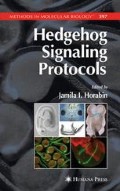Abstract
Many of the genes of Drosophila melanogaster have their transcripts deposited in developing oocytes. These maternally loaded gene products enable an otherwise homozygous mutant embryo to survive beyond the first stage of development for which the gene product is required. Zygotic mutations that disrupt the Hedgehog signal transduction pathway typically yield a segment polarity ‘lawn of denticles’ cuticle phenotype. However, an embryo homozygous mutant for a gene can achieve normal embryonic segmentation precluding classification of the gene as a component of the Hh pathway, if wild-type transcripts from the mother are present. This chapter discusses the theory and importance of analyzing germline clone embryos for maternally acting genes involved in Hh signal transduction, and describes in detail the method to generate mutant germline clone embryos.
Access this chapter
Tax calculation will be finalised at checkout
Purchases are for personal use only
References
Arbeitman, M. N., Furlong, E. E., Imam, F., et al. (2002) Gene expression during the life cycle of Drosophila melanogaster. Science 297, 2270–2275.
Chou, T. B. and Perrimon, N. (1992) Use of a yeast site-specific recombinase to produce female germline chimeras in Drosophila. Genetics 131, 643–653.
Chou, T. and Perrimon, N. (1996) The autosomal FLP-DFS technique for generating germline mosaics in Drosophila melanogaster. Genetics 144, 1673–1679.
Chou, T. B., Noll, E., and Perrimon, N. (1993) Autosomal P[ovoD1] dominant female-sterile insertions in Drosophila and their use in generating germ-line chimeras. Development 119, 1359–1369.
The, I., Bellaiche, Y., and Perrimon, N. (1999) Hedgehog movement is regulated through tout velu-dependent synthesis of a heparan sulfate proteoglycan. Mol. Cell. 4, 633–639.
Han, C., Belenkaya, T. Y., Khodoun, M., Tauchi, M., Lin, X., and Lin, X. (2004) Distinct and collaborative roles of Drosophila EXT family proteins in morphogen signaling and gradient formation. Development 131, 1563–1575.
Ingham, P. W. and Martinez Arias, A. (1992) Boundaries and fields in early embryos. Cell 68, 221–235.
Perrimon, N. (1994) The genetic basis of patterned baldness in Drosophila. Cell 76, 781–784.
DiNardo, S., Sher, E., Heemskerk-Jongens, J., Kassis, J. A., and O’Farrell, P. H. (1988) Two-tiered regulation of spatially patterned engrailed gene expression during Drosophila embryogenesis. Nature 332, 604–609.
Martinez-Arias, A., Baker, N., and Ingham, P. W. (1988) Role of segment polarity genes in the definition and maintenance of cell states in Drosophila embryo. Development 103, 157–170.
Heemskerk, J., DiNardo, S., Kostriken, R., and O’Farrell, P. H. (1991) Multiple modes of engrailed regulation in the progression towards cell fate determination. Nature 352, 404–410.
Bejsovec, A. and Martinez Arias, A. (1991) Roles of wingless in patterning the larval epidermis of Drosophila. Development 113, 471–485.
Rothwell, F. and Sullivan, W. (2000) Fluorescent analysis of Drosophila embryos. In Drosophila Protocols, Cold Spring Harbor Laboratory Press, New York, pp. 141–157.
Patel, N. H. (1994) Imaging neuronal subsets and other cell types in whole-mount Drosophila embryos and larvae using antibody probes. Methods Cell Biol. 44, 445–487.
Parthasarathy, N., Lecuyer, E., and Krause, H. M. (2005) Optimized protocols for fluorescent in situ hybridization in Drosophila tissues. In Methods in Molecular Biology: Protocols in Confocal Microscopy (Paddock, S., ed.) Humana Press Inc.
Tautz, D. and Pfeifle, C. (1989) A non-radioactive in situ hybridization method for the localization of specific RNAs in Drosophila embryos reveals translational control of the segmentation gene hunchback. Chromosoma 98, 81–85.
Hatini, V. and DiNardo, S. (2001) Divide and conquer: pattern formation in Drosophila embryonic epidermis. Trends Genet. 17, 574–579.
Franch-Marro, X., Marchand, O., Piddini, E., Ricardo, S., Alexandre C., and Vincent J. P. (2005) Glypicans shunt the Wingless signal between local signaling and further transport. Development 132, 659–666.
Author information
Authors and Affiliations
Editor information
Editors and Affiliations
Rights and permissions
Copyright information
© 2007 Humana Press Inc., Totowa, NJ
About this protocol
Cite this protocol
Selva, E.M., Stronach, B.E. (2007). Germline Clone Analysis for Maternally Acting Drosophila Hedgehog Components. In: Horabin, J.I. (eds) Hedgehog Signaling Protocols. Methods Inmolecular Biology™, vol 397. Humana Press. https://doi.org/10.1007/978-1-59745-516-9_11
Download citation
DOI: https://doi.org/10.1007/978-1-59745-516-9_11
Publisher Name: Humana Press
Print ISBN: 978-1-58829-692-4
Online ISBN: 978-1-59745-516-9
eBook Packages: Springer Protocols

